data-viz-workshop-2021
Data graphics: Excellent, good, bad, or weird?
Please classify each of the plot as excellent, good, bad, or ugly.
“The best way to learn how to make effective graphics is by dissecting why some graphics are effective and others are not, and determining how they can be improved.” - by Felice C. Frankel (Author)
1. The asian surge
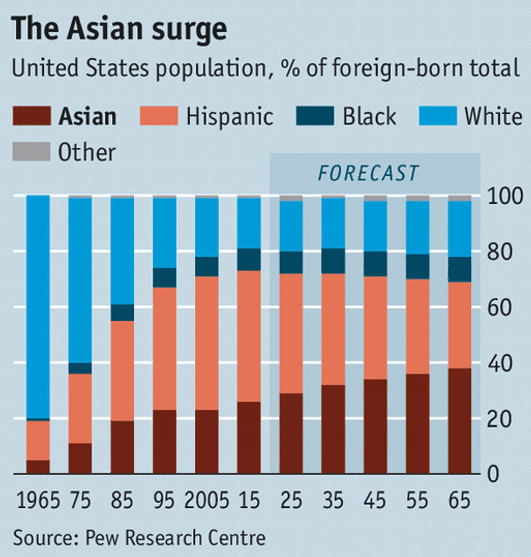
Context (& source): The Economist article titled “The model minority is losing patience” informs that Asian-Americans in the US, a minority considered successful, also face prejudices and discrimination. To study (implicit) the bias and stereotypes against Asians in America, historical mass migration data is analyzed, and probable future projections of the trends are discussed.
Graphic (explanation without interpretation): This plot in the article, with time (years) in x-axis and US foreign-born population distribution (in percentage) in y-axis, presents how the percentage of Asian, Hispanic, Black, and White population has been increasing or decreasing since 1965. Overall, the plot depicts that the percentage of Asians is continuing to increase, compared to the White foreign-born population.
Analysis (our interpretation & critical analysis): The data for this plot has three dimensions (columns): 1) year, 2) % of foreign-born population, and 3) race. Each year, total foreign-born populations is the percentagee sum of all individual foreign-born races. The stacked bar graph here is a fit when one of the dimensions is a fixed-sum type. Intentional de-labeling of the axes is appropriate because they are obvious. Contrasting colors are used for each race for increased clarity. Light (almost unnoticeable) shading of the forecasted data illustrates an extremely confident prediction.
2. Land of the free

Context: The Economist article titled “The model minority is losing patience” compares the advantage of living in America with living in the country of origin, as reported by Asian-Americans.
Graphic: The graph depicts the comparison between America and other countries across many categories. The x-axis represents the percentage of participants saying that a particular category is better in their home country vs in America. The y-axis represents the various categories in which the comparison is being made. In this case it can be seen that the only category that the participants think that their home country is better in is “strength of family ties”.
Analysis: You do! We will share our analysis soon.
3. Household income vs happiness
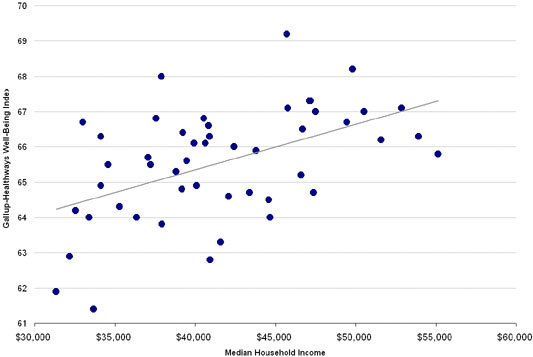
Context: The article “The Happiest States of America” summarizes the survey results and informs that Utah is the happiest state in the US. The Gallup-Healthways well-being index (the metric to access happiness) includes factors like life evaluation, emotional health, physical health, healthy behavior, work environment and basic access — all of which is said to contribute to the happiness of an individual. A reader of the article may be interested to learn what makes a state happy. As an investigation, the authors compared the happiness scores with median state incomes.
Graphic: The scatterplot shows the ‘possible’ positive relationship between a state’s median household income (in x-axis) and its well-being (y-axis). There are 50 dots in the plot.
Analysis: You do! We will share our analysis soon.
4. The age of a first mother

Context: The New York Times article “The Age That Women Have Babies: How a Gap Divides America” analyzes the factors that could influence a woman’s decision regarding the right time for her to beget a baby. It shows how the trend has changed in 2016. The article also talks about the inequality that is rampant in the workforce which forces women to postpone, if not cancel, their plans of giving birth.
Graphic: This is an animated plot. With “age” on the x-axis and the “percentage of women” on the y-axis, the plot shows the change in the distribution of the data in 1980 vs 2016. The moving graphic (video) highlights the contrast (drastic difference) in distribution.
Analysis: You do! We will share our analysis soon.
5. The Senate’s scientific divide

Context: This article in The Economist presents some interesting data about the engagement of senators — regarding science-related news — on their Twitter feed. The article has analyzed the partisan division of the republic and Democratic senators on following the “scientific” twitter accounts such as NASA.
Graphic: The plot, with the “Liberal-conservative score” on the x-axis and the “percentage of science-related accounts followed on Twitter” on the y-axis aims to depict that the Democratic senators are more likely to follow science-related accounts on Twitter than Republican counterparts.
Analysis: You do! We will share our analysis soon.
6. America’s immigration debate
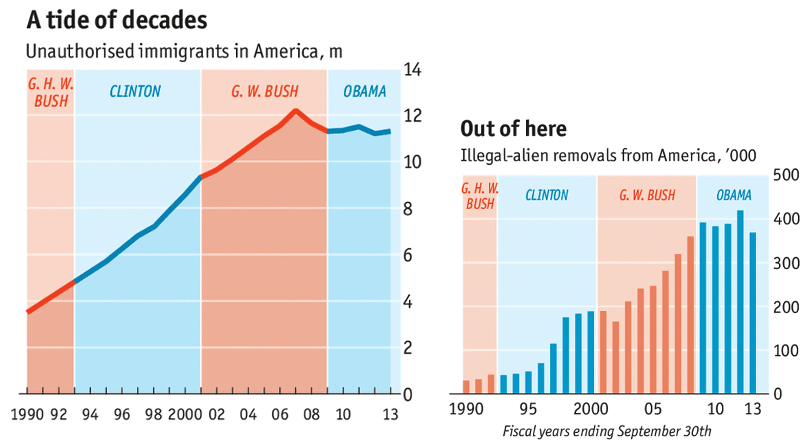
Context: These two graphics are from the article “America’s immigration debate” article in The Economist.
Graphics: They depict the influx of unauthorized immigrants in America from 1990 to 2013 (in the first graph) and the number of deportations done in those years under the administration of respective presidents (in the second graph). Together, these two graphs tell many stories about America’s immigration. When President Clinton and President GW Bush were presidents, the number of illegal immigrants was increasing each year but the illegal alien removal also was increasing steadily. Similarly, when President Obama was the president, the number of illegal immigrants roughly stayed constant but so did the removals.
Analysis: You do! We will share our analysis soon.
7. Causes of cancer
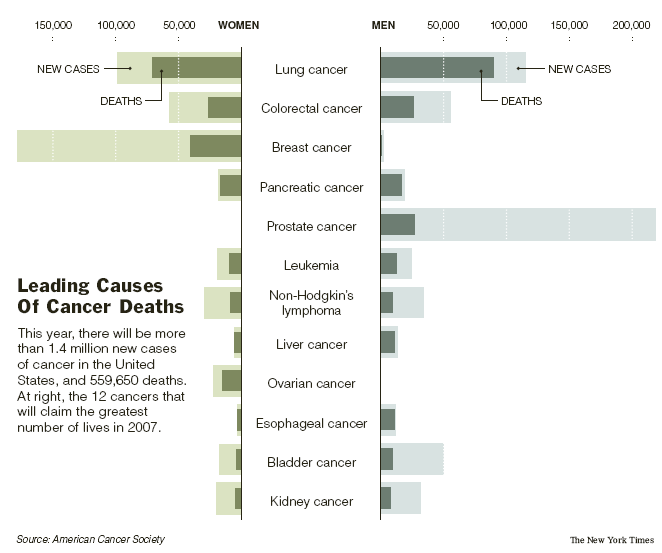
Context: The article talks about the growing number of men and women who suffered from different types of cancers in the year 2007, while also mentioning the growing number of deaths brought upon by those cancers. NYTimes probably removed the original article containing this graph.
Plot: The mirror bar diagram compares new cases with deaths and men with women.
Analysis: You do! We will share our analysis soon.
8. Career earnings for college graduates
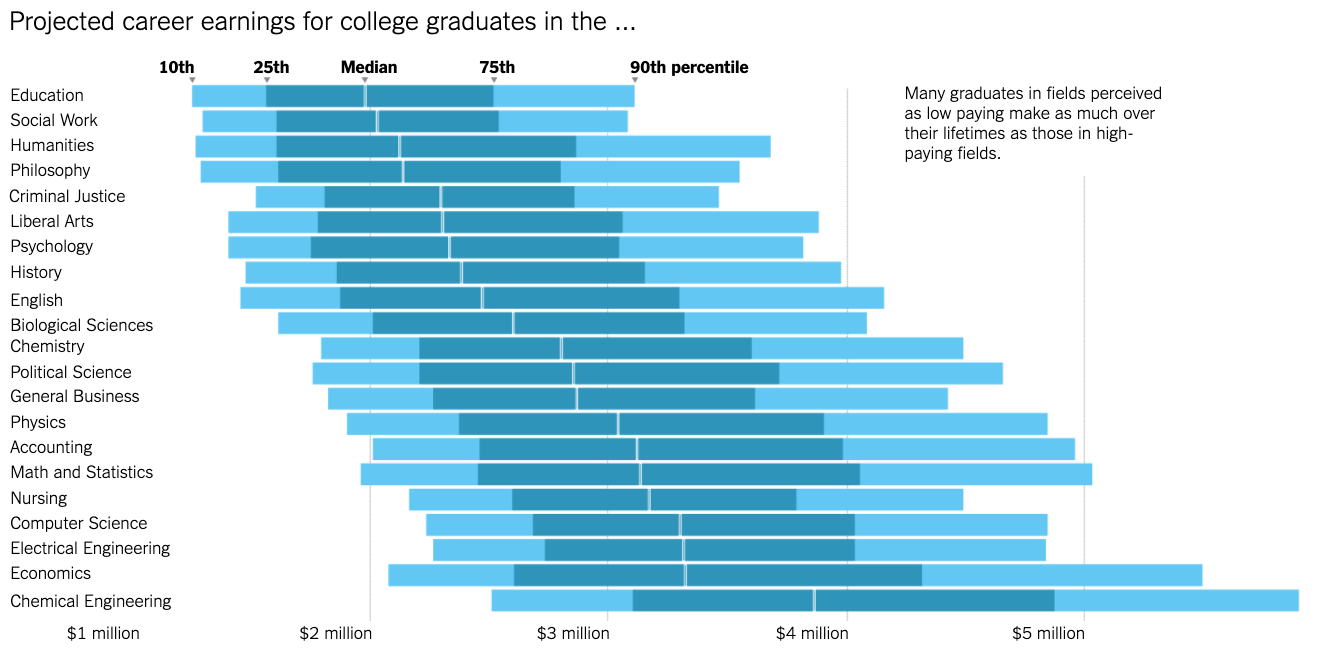
Context: The article “Six Myths About Choosing a College Major” in NYTimes tries to bust the myths about choosing a major in college. It discredits some of the widely-believed myths about choosing majors in colleges such as the saying that choice of major matters more than the choice of college. The author has considered the college students based on their percentiles in any given subject and has projected the lifetime career earnings of students of different percentiles in various majors.
Graphic: The box-plot-like chart shows the central tendency (median) and interquartile ranges across many categories.
Analysis: You do! We will share our analysis soon.
9. Advanced learning
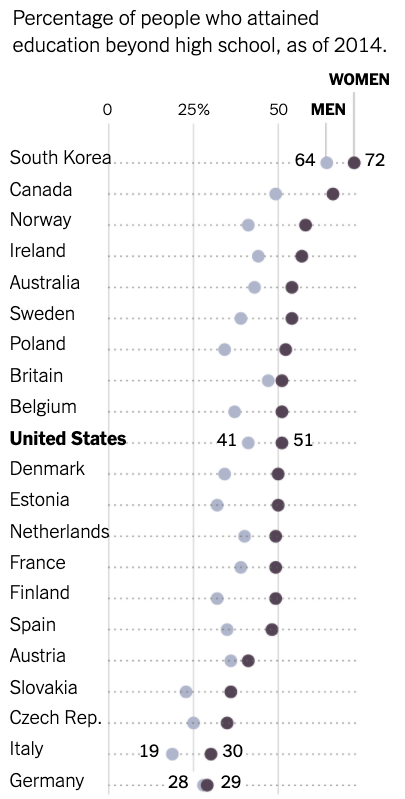
Context: The NYTimes article “Community Colleges Draw From Abroad” highlights that for many American universities and colleges, the world is getting farther away. According to the article, international enrollment in the United States is flat or down after many years when visitors flocked here to learn.
Graphic: Advanced learning (the percentage of people who attain an education beyond high school) is an indicator of the educational success of a country. This dot plot compares the advanced learnings of selected developed countries and shows that South Korea is in the lead. It depicts the comparison, between men and women, of the percentage of people who attained education beyond high school.
Analysis: You do! We will share our analysis soon.
10. Airplanes are getting safer than ever before
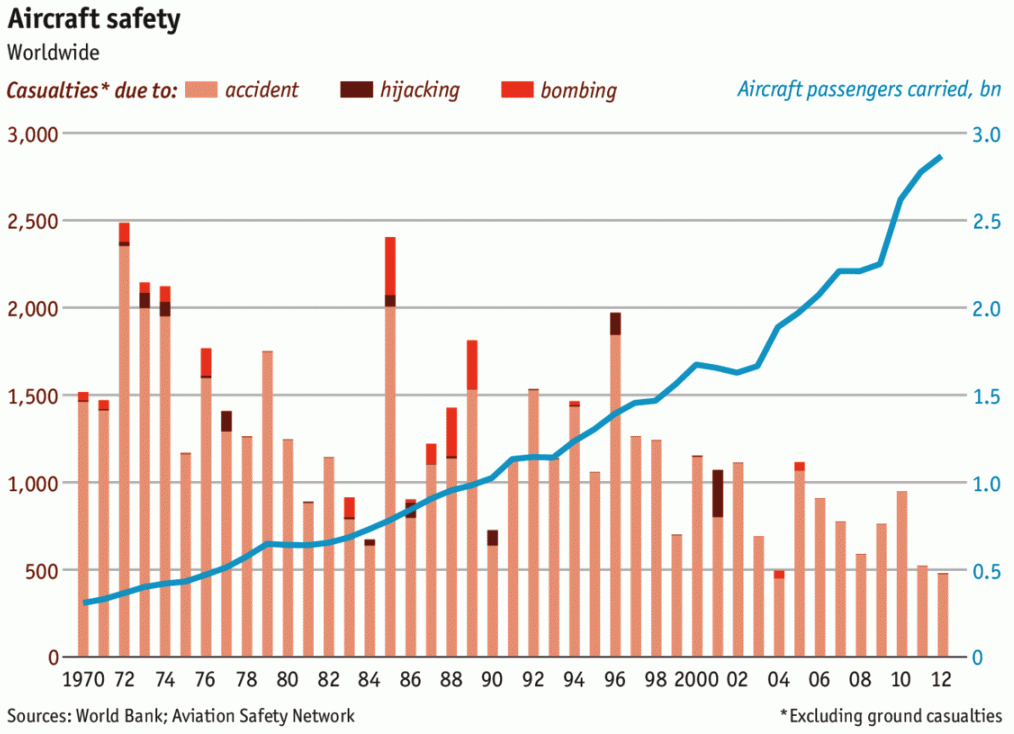
Context: This Economist article “Safe skies” asserts that airplanes are getting safer than ever before despite some rare yet fatal accidents. The purpose of this graph is to show, to a reader, that the number of casualties from airplane-related tragedies such as accidents, hijacking, and bombing has decreased over time, even if the number of passengers has increased.
Graphic: The plot shows the number of airplane casualties (worldwide) over the period of around 40 years.
Analysis: You do! We will share our analysis soon.
11. Corruption and human development
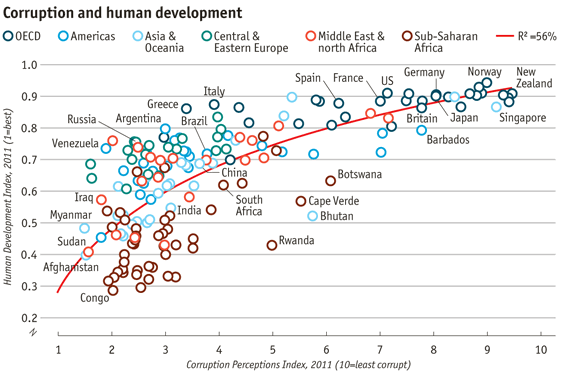
Context: The article “Corrosive corruption” speaks how corruption varies across many countries and groups based on their economy/general standards of living.
Graphic: The graph shows the relationship between the ‘corruption perceptions index’ and ‘human development index’ across groups and several countries.
Analysis: You do! We will share our analysis soon.
12. Europe’s GDP decrease
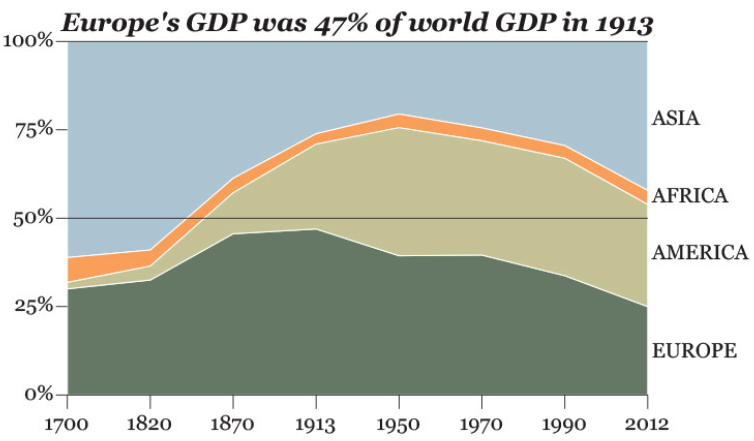
Context: In his book “Capital in the Twenty-First Century”, Thomas Piketty focuses on wealth and income inequality in Europe and the United States since the 18th century. The book’s central thesis is that when the rate of return on capital (r) is greater than the rate of economic growth (g) over the long term, the result is a concentration of wealth, and this unequal distribution of wealth causes social and economic instability.
Graphic: In this graphic, Piketty shows how Europe made 47 percent of world GDP in 1913 and it went down to 25 percent in 2012.
Analysis: You do! We will share our analysis soon.
13. How the virus transformed the way americans spend their money?

Context: The article “CoronaVirus US Economy Spending” speaks how the virus affected Americans spending in various industries.
Graphic: In this bubble chart, each bubble represents a spending category. The diameter of the bubble represents the industry sales for the corresponding category. The horizontal axis represents the percentage change in credit and debit card purchases. Each consumer category has a total sales value (represented by the bubble’s diameter) and a percentage change in Y purchases.
Analysis: You do! We will share our analysis soon.
14. The World Cup’s big guns % of team’s runs scored by top scorer

Context: The article “Williamson is so valuable to New Zealand” talks about the outstanding contributions of Kane Williamson’s and why Williamson is so valuable to New Zealand by showing his scores contribution to his team.
Graphic: In this Donut chart, each portion or pie represents the world’s top cricket player’s contribution of their score to their International cricket team’s score. This donut chart shows that Kane Williamson made the highest score contribution to his team, and thus he is the most valuable player to New Zealand.
Analysis: You do! We will share our analysis soon.
15. Tesla’s stock trend looks like what Netflix did a decade ago

Context: The article “Tesla and Netflix share similarity” talks about how Tesla’s downfall in 2019 looks similar to that of Netflix shares from 2011-2013.
Graphic: The objective of the chart is to show the similarity of Tesla and Netflix stocks. Tesla’s stock in 2019 looks very similar to Netflix’s stock performance in 2011. The x-axis has different timelines June 2011 - Nov 2013 and Jan 2019 - Today. The graph with the orange line is related to teslas stock plotted against the x-axis line Jan 2019 - Today, and the blue line is the Netflix line graph with the x-axis being June 2011 - Nov 2013. The Y-axis has two scales, the left side of the axis starting with 0 and the right y-axis starting scale with 160.
Analysis: You do! We will share our analysis soon.
Content contributors:
Badri Adhikari, Sijal Dhakal, Bikash Shrestha, and Amulya Reddy Lakku.